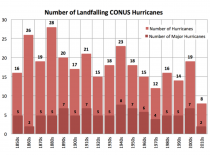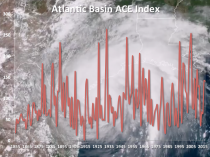By Michael Sununu, Union Leader
LET US SET hyperbole aside. Climate change is NOT making hurricanes stronger or more frequent.
Statements to the contrary by climate scientists like Michael Mann and Tom Peterson are not based on objective analysis of historical data. Most of the claims by the alarmists are based on hypothetical model projections, an ill-informed understanding of weather, and a desire to ignore the historical precedents which indicate the current environment is no different than the past.
Alarmists claim flooding caused by Harvey was the worst ever. In fact, those areas of coastal Texas have seen similar flooding in the past. In 1978, tropical storm Amelia dumped 48 inches of rain on Texas, and the following year, Claudette inundated the state with 54 inches, with one location in Alvin, Texas, receiving 43 inches in a 24-hour period (a record).
These two storms occurred during the late 1970s’ cooler climate. In 1954, Hurricane Alice dropped huge amounts of rain in the Rio Grande Valley. In 1935, Harris County saw its worst floods, with waters reaching the second and third stories in Houston. Harvey was not unprecedented.
The forces behind these huge rain totals are local weather patterns that stall storm systems over the state. WeatherBell’s chief forecaster, Joe Bastardi, pointed out that a major trough extended south and trapped Harvey just onshore. This allowed the storm to suck up warm moisture from the Gulf and continue to drop it in the same area over several days. Thirty- to forty-inch rain totals are not a common occurrence, but they do occur every decade or so in Texas.
The second claim is that the U.S. is seeing stronger hurricanes than in the past, because climate change is raising hurricane intensity. Nothing could be further from the truth. Looking at the historical records, Roger Pielke Jr. has noted that in the 44-year period between 1926 and 1969, fourteen Category 4 or 5 hurricanes made landfall in the United States. Over the next 47 years, between 1970 and 2017, just four hit the United States, and that includes Harvey this year. We are seeing fewer major hurricanes hit the U.S., not more.
Others have noted that Irma was a very intense hurricane reaching very low pressures, and this is true. Irma reached as low as 914mb and wind speeds of 185 mph. Hurricane Wilma in 2005 holds the record with the lowest pressure in the Atlantic basin at 882mb. When you look at historical storms, Wilma was comparable to the Great 1935 Labor Day hurricane that made landfall with pressure at 892mb, the only storm to make landfall below 900mb. Since there were no Hurricane Hunter aircraft in that era, it is quite possible that the 1935 storm had pressures even lower than Wilma.
There is evidence that the Great Hurricane of 1780, which destroyed much of the eastern Caribbean, may have had windspeeds in excess of 200 mph. It destroyed every house and fort on Barbados, stripped the bark off trees, and killed over 22,000 people in the region.
Clearly, Mother Nature has always been very capable of generating storms far more intense than what we have seen recently.
Climate alarmists don’t want to talk about the uncomfortable fact we just went through an historic 12-year period without a major hurricane (Category 3 or higher) making landfall in the United States. We were blessed for more than a decade without a devastating hurricane wreaking havoc on our shores, so having two hurricanes making landfall this year, while unfortunate, should not be unexpected.
What is disappointing, unnecessary, and counterproductive is the attempt to somehow link carbon dioxide emissions to hurricane activity. Both the IPCC and NOAA have made clear statements that there is no scientific evidence that links CO2 levels with extreme weather, including tropical systems. Any linkage is purely hypothetical, and is more likely a political rather than a scientific determination.
In the real world, fossil fuels are what make our communities resilient. They provide us the concrete to reinforce our homes, the fuel to help move us away from danger, the materials to preserve and rebuild our infrastructure, and the electricity to bring back our communities when the storm passes. They power the rescue boats and aircraft, help deliver the food and water to stricken communities, and power the chainsaws that allow us to clear the debris.
Carbon dioxide is not powering these storms, but it does make our lives better both before they hit, and after they leave disaster in their wake.
Michael Sununu is a consultant with Sununu Enterprises LLC and lives in Newfields.






